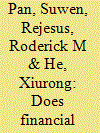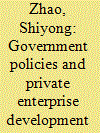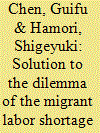|
|
|
Sort Order |
|
|
|
Items / Page
|
|
|
|
|
|
|
| Srl | Item |
| 1 |
ID:
090111


|
|
|
|
|
| Publication |
2009.
|
| Summary/Abstract |
In the published literature, the differences in environmental performance across countries are typically explained using the Environmental Kuznets Curve. The Environmental Kuznets Curve states that pollution initially increases with economic growth. Once GDP per capita reaches a certain level, the relationship reverses. In the present paper, we provide an alternative hypothesis, where budget structure plays an important role in explaining the variations in pollution across the world: the lower the business-related taxes as a share of total tax revenue, the higher the property tax in total tax revenue and the higher the ratio of public health expenditure in total expenditure, then the stronger the incentive of pollution control and the lower the pollution level. Our empirical findings reveal that the budget structure does have an important impact on pollution control. The policy implication of this research is that effective control of environmental pollution requires changes in tax structure and expenditure assignment. This research has important policy implications for China's tax system reform and pollution control efforts.
|
|
|
|
|
|
|
|
|
|
|
|
|
|
|
|
| 2 |
ID:
090110


|
|
|
|
|
| Publication |
2009.
|
| Summary/Abstract |
This paper investigates the impacts of financial intermediary (or banking) development on village-level per capita income using a Chinese dataset for selected years between 1993 and 2006. The empirical results from a random effect regression model indicate that mean per capita income in rural villages follows an inverted U-shaped path as financial intermediation develops. However, using a pooled quantile regression approach, we find that median per capita income in rural villages follows a positive linear path, rather than an inverted U-shaped path, as financial intermediation develops. The positive linear effect of financial intermediary development is observed at the lower and higher ends of the conditional per capita income distribution. This suggests that development of financial intermediation in China might not have statistically significant differential effects in low-income or high-income rural villages.
|
|
|
|
|
|
|
|
|
|
|
|
|
|
|
|
| 3 |
ID:
090108


|
|
|
|
|
| Publication |
2009.
|
| Summary/Abstract |
The relationship between government policy and economic development has been along-standing topic of academic research and policy debate. The government of a transitional economy plays an important role in the process of economic development. Over the past three decades, the Chinese economy has been growing very rapidly, in particular because of the rapid development of the private sector. However, the performance of private enterprises is still affected by government policies. In the present paper, we examine the changes in large Chinese private enterprises' performance during 2003-2006 and test the determinants of such changes. We conclude that the Chinese Government's discriminating policies against private enterprises are the main cause of the private sector's downturn.
|
|
|
|
|
|
|
|
|
|
|
|
|
|
|
|
| 4 |
ID:
090107


|
|
|
|
|
| Publication |
2009.
|
| Summary/Abstract |
Economic theory posits numerous channels through which FDI might create positive spillovers for domestic firms. However, the results of empirical studies that have sought to document these spillovers have been mixed. One explanation for this variation is that the capacity of domestic firms to absorb spillovers might vary. In the present paper, we explore these issues in the case of China. Aside from being one of the world's leading hosts of foreign direct investment, China makes for an interesting case study because its provinces vary greatly with respect to those factors most commonly held to influence absorptive capacity, such as the initial level of technology in domestic firms. This paper begins by empirically establishing that the spillovers from foreign direct investment do indeed vary across provinces. Threshold values for various factors that influence absorptive capacity factors are then estimated and it is found that conditions in many provinces presently fall short of these values. This provides an obvious focus of attention for China's policy-makers.
|
|
|
|
|
|
|
|
|
|
|
|
|
|
|
|
| 5 |
ID:
090112


|
|
|
|
|
| Publication |
2009.
|
| Summary/Abstract |
The current global financial and economic crisis is giving new life to initiatives that promote closer economic integration among East Asian countries. A significant example is the ASEAN-China Free Trade Area (ACFTA), which is set to come into effect around 2010. ACFTA aims to boost trade between two economies that are partners as well as competitors: ASEAN and China. In the present paper, we use insights from customs union theory in a qualitative analysis considering whether ACFTA would benefit both sides. We also apply a computable general equilibrium model to perform a quantitative analysis of the same issue. Both our qualitative and quantitative analyses provide grounds for guarded optimism regarding ACFTA's prospects as a vehicle for strengthening the economic partnership between ASEAN and China.
|
|
|
|
|
|
|
|
|
|
|
|
|
|
|
|
| 6 |
ID:
090109


|
|
|
|
|
| Publication |
2009.
|
| Summary/Abstract |
Since 2003, China's labor market has been facing two coexisting crises: a rural labor surplus and a severe shortage of migrant labor. Using data from the 2000 China Health and Nutrition Survey questionnaire, which covers 288 villages in 36 counties, this paper attempts to find a solution to this dilemma. Specifically, a multinomial logit model, a Mincer-type model and a probit model are applied to examine the effect of educational level on the employment choices for rural laborers, and on the wages and the employment status of migrants. Based on the results of our analysis, we propose the implementation of policy aimed at increasing the educational level of rural dwellers, in conjunction with other policies to eliminate all artificial barriers, to facilitate the migration of rural laborers.
|
|
|
|
|
|
|
|
|
|
|
|
|
|
|
|
| 7 |
ID:
090106


|
|
|
|
|
| Publication |
2009.
|
| Summary/Abstract |
The subprime mortgage crisis and the resultant inflationary monetary policy in the USA have left the Chinese economy subject to four risks in particular. First, China's exports to the USA might continue to decline. Second, in the medium term, the higher US inflation rate will lead to a weak dollar, which will negatively affect China's exports. Third, in the long term, when the US Federal Reserve decreases money supply to control inflation, the US economy might enter another recession, hurting China's exports further. Fourth, China's foreign exchange reserve assets might suffer heavy losses when the US inflation rate rises. Conventional foreign exchange investment strategies are insufficient for dealing with these four risks. Investment by China in the major US banks is suggested in the present paper. This strategy would mitigate if not eliminate all four risks. China could gain considerable financial returns on investments with only moderate risk.
|
|
|
|
|
|
|
|
|
|
|
|
|
|
|
|
|
|
|
|
|